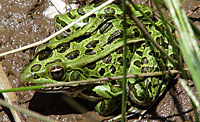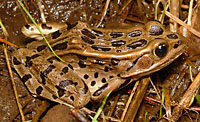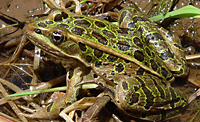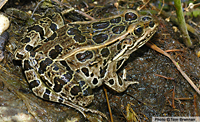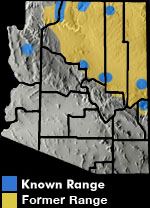Online Field Guide to The Reptiles and Amphibians of Arizona


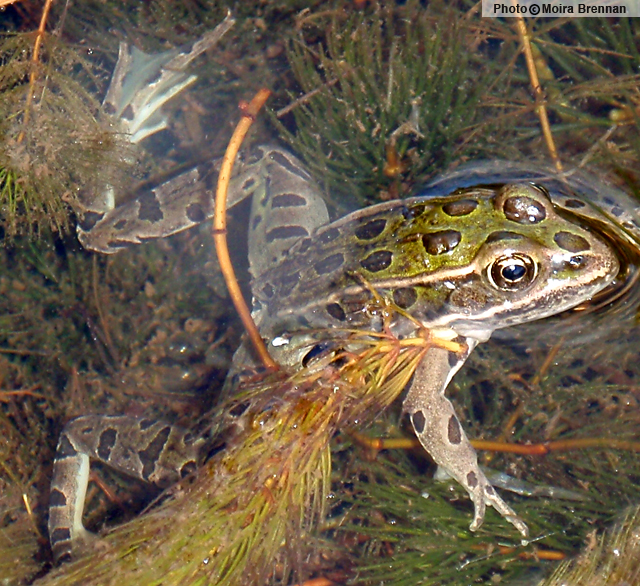
Coconino County, AZ
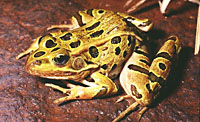 Arizona |
||
| NORTHERN LEOPARD FROG Lithobates pipiens | |
|
DESCRIPTION: In Arizona, the northern leopard frog is a smooth-skinned green, brown, or sometimes yellow-green frog with well-defined dark spots. One large dark spot is typically present on the snout. This is the only Arizona leopard frog with complete dorsolateral folds. The pattern on the rear of the thigh is also diagnostic, and includes a few dark spots or blotches on a light background. A big northern leopard frog is about 4.5 inches in length. Tadpoles are similar to the Plains leopard frog, but less pale, and with dark spots and patches on the tail. Tadpoles reach 3.25 inches total length. DISTRIBUTION: Historically, the northern leopard frog was well-distributed across northern and central Arizona, including wetlands in wooded areas and meadows above and below the Mogollon Rim, as well as in more open and arid country on the Colorado Plateau. Northern leopard frogs have declined, often dramatically, across the western United States and southwestern Canadian Provinces. Arizona is no exception. The last known stronghold of the species in Arizona is a complex of cattle tanks and a lake below the Mogollon Rim on the Coconino National Forest. Few other populations exist. In 2006, it was recently reestablished to four sites in the House Rock Valley; however, northern leopard frogs are apparently extirpated from the White Mountains, and the Apache-Sitgreaves and Kaibab National Forests. HABITAT: In Arizona, the northern leopard frog inhabited mostly ponds, cattle tanks, and lakes, but was also found in streams and rivers from 3,120 to 9,150 feet elevation. It is currently limited to cattle/wildlife tanks and a lake. BEHAVIOR: Can be found active day or night when water temperatures are roughly >54 degrees F. May be active in wet meadows away from water during summer. DIET: Northern leopard frogs eat a variety of aquatic and terrestrial invertebrates. Larger frogs eat small leopard frogs, other amphibians, fish, snakes, and other vertebrates, as well. REPRODUCTION AND CALLS: Not well documented in Arizona, but breeding probably occurs from April-July (late summer breeding has been documented in New Mexico). In Glen Canyon, Arizona, northern leopard frogs probably deposit egg masses during late April–early May. Most tadpoles likely metamorphose in 3-6 months before the fall cool down, but some tadpoles in Arizona overwinter. The advertisement call is a medley of chuckles, snores, and grunts. REMARKS: Causes of decline include drought and non-native predators, but other factors have likely played a role, as well. Although not documented in the species in Arizona, northern leopard frogs in other regions have suffered from the fungal skin disease, chytridomycosis. A 2004 study found that populations west of the Mississippi River and Great Lakes Region are genetically quite different from eastern populations. The western populations have been petitioned to be listed as threatened under the Federal Endangered Species Act. By Jim Rorabaugh PROTECTED
Drost, C.A., and M.K. Sogge. 1993. Survey of an isolated northern leopard frog population along the Colorado River in Glen Canyon National Recreation Area. National Park Service/Cooperative Park Studies Unit, Northern Arizona University Report, Flagstaff, Arizona. Hoffman, E.A., M.S. Blouin. 2004. Evolutionary history of the northern leopard frog: reconstruction of phylogeny, phylogeography, and historical changes in population demography from mitochondrial DNA. Evolution 58(1):145-159. Rorabaugh, J.C. 2005. Rana pipiens Schreber, 1782, Northern leopard frog. Pages 570-577 in M.J. Lannoo (ed), Amphibian Declines: The Conservation Status of United States Species. University of California Press, Berkeley. |
|
Visit Partners in Amphibian and Reptile Conservation:


HOME
Copyright © 2023, Arizona Game and Fish Department. All rights reserved.
If you make use of the textual contents of this site in reports, publications, etc. please cite and credit the author(s) and photographer(s). All photos on this website are copyrighted. However, those found in the species account section may be used for any noncommercial scientific, educational, or conservation purposes provided that photographs are not altered and continue to bear the copyright symbol and name of the photographer. Please contact the photographer regarding commercial use of copyrighted photographs.










